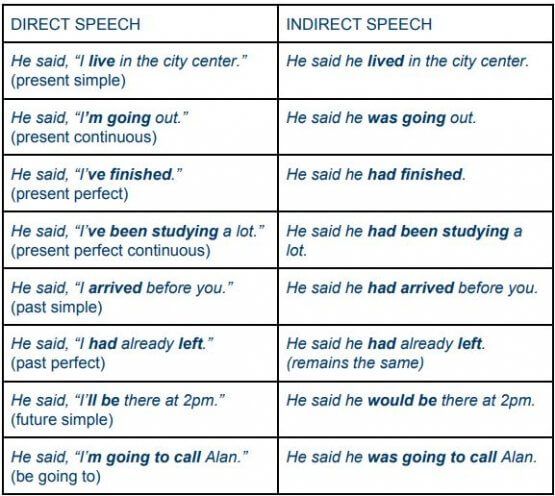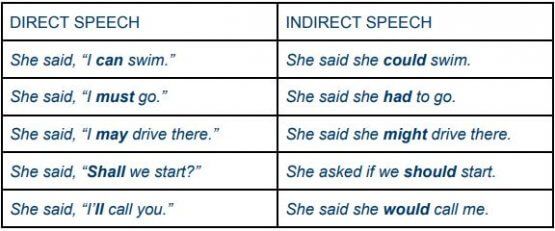- English Grammar
- Grammar Exercises
- Direct And Indirect Speech Exercises

Direct and Indirect Speech Exercises
Direct and indirect speech is one topic in English grammar that confuses most language learners. It need not necessarily be so; if you understand how it works, you can easily use it in your writing.
Direct and Indirect Speech Exercises with Answers
When converting direct speech to indirect speech or vice-versa, you will have to take care to convert the verb , pronoun and the adverb appropriately. Go through the following exercises and try them out. Answers are given below each exercise; refer to them to see if your answers are right.

Exercise 1: Change into indirect speech
Read the following sentences and convert them into indirect speech.
- Rahul told to me, “When are you leaving?”
- “Where do you live?” the stranger asked Aladdin.
- The teacher said to Shelly, “Why are you laughing?”
- Dhronacharya said to Arjun, “Shoot the bird’s eye.”
- “Call the first convict,” said the jury.
- “Call the ambulance,” said the man.
- Bruce said to me, “I shall do the work.”
- My mother said to me, “You were wrong.”
- Mr Richard said to me, “Please wait here till I return.”
- The captain said to me, “Bravo! You have played well.”
- Raj said, “Alas! My pet died.”
- Ruchi said, “I may go there.”
- Bucky said to Steve, “Do you hear me?”
- The boy said, “Let me come in.”
- Granny said to me, “May God bless you.”
Answers –
- Rahul asked me when I was leaving.
- The stranger asked Aladdin where he lived.
- The teacher asked Shelly why he was laughing.
- Dhronacharya ordered Arjun to shoot the fish’s eye.
- The jury ordered to call the first convict.
- The man urged to call the ambulance.
- Bruce said to me he would do the work.
- My mother told me that I was wrong.
- Mr Richard requested me to wait there till he returned.
- The captain applauded me, saying that I had played well.
- Raj exclaimed sadly that his pet died.
- Ruchi said that she might go there.
- Bucky asked Steve if he heard him.
- The boy asked to let him come in.
- Granny prayed that God might bless me.
Convert the following into Direct Speech
Read the following passage and convert it into direct speech.
One of them told Issac that the latter had forgotten one thing that belonged to a mill. Issac enquired what that was. The friend asked where the miller was. Issac replied that (absence of the miller) was true – and he must look for one.
“But Issac,” said one of them, “you have forgotten one thing that belongs to a mill.”
“What is that?” asked Issac.
“Why, where is the miller?” said his friend.
“That is true – I must look for one,” said Issac.
Frequently Asked Questions
What is direct narration.
When the actual words/sentences as spoken by the speaker are quoted in a speech, it’s called direct speech/narration.
What is indirect speech?
When the quoted speech is reported in the form of a narrative without changing the meaning of the actual quotation/words by the speaker, it’s called indirect speech/narration.
Leave a Comment Cancel reply
Your Mobile number and Email id will not be published. Required fields are marked *
Request OTP on Voice Call
Post My Comment
Register with BYJU'S & Download Free PDFs
Register with byju's & watch live videos.

Reported speech - 1
Reported speech - 2
Reported speech - 3
Worksheets - handouts

Reported speech
Worksheets - pdf exercises.
- Reported statements - worksheet
- Worksheet - reported questions
- Reported yes/no questions
- Worksheet - reported speech
- Reported speech - exercises pdf
- Indirect speech - exercises
- Reported speech - exercises
- Mixed reported speech 1
- Mixed reported speech 2
- Reported speech 1
- Reported speech 2
- Reported speech 3
- Reported speech 4
- Reported speech 5
- Reported wh- questions
- Reported speech - worksheet
- Reported commands
- Reported questions
- Reported speech 1
- Reported speech 2
- Reported requests and orders
- Reported speech exercise
- Reported questions - worksheet
- Indirect speech - worksheet
- Worksheets pdf - print
- Grammar worksheets - handouts
Grammar - lessons
- Reported speech - grammar notes
- How to use reported speech - lesson
- Tense changes - grammar
Choose a region
Direct and indirect speech exercises
There are many occasions in which we need to describe an event or action that happened, and very often that includes repeating what someone said. Such occasions can include a social situation as well as in a work email or presentation. In order to describe what people said there are two different types of speech – direct speech and indirect speech (or reported speech).
Read the article below to find out more about these forms and improve your English storytelling skills.
Do you want to practice your English speaking skills with small classes with native-level teachers? Find out more about Speak+ now
Direct Speech
When we want to describe what someone said, one option is to use direct speech . We use direct speech when we simply repeat what someone says, putting the phrase between speech marks:
- Paul came in and said, “I’m really hungry.”
It is very common to see direct speech used in books or in a newspaper article. For example:
- The local MP said, “We plan to make this city a safer place for everyone.”
As you can see, with direct speech it is common to use the verb ‘to say’ (‘said’ in the past). But you can also find other verbs used to indicate direct speech such as ‘ask’, ‘reply’, and ‘shout’. For example:
- When Mrs Diaz opened the door, I asked, “Have you seen Lee?”
- She replied, “No, I haven’t seen him since lunchtime.”
- The boss was angry and shouted, “Why isn’t he here? He hasn’t finished that report yet!”
Indirect Speech
When we want to report what someone said without speech marks and without necessarily using exactly the same words, we can use indirect speech (also called reported speech). For example:
- Direct speech: “We’re quite cold in here.”
- Indirect speech: They say (that) they’re cold.
When we report what someone says in the present simple, as in the above sentence, we normally don’t change the tense, we simply change the subject. However, when we report things in the past, we usually change the tense by moving it one step back. For example, in the following sentence the present simple becomes the past simple in indirect speech:
- Direct speech: “I have a new car.”
- Indirect speech: He said he had a new car.
All the other tenses follow a similar change in indirect speech. Here is an example for all the main tenses:

The same rule of moving the tenses one step back also applies to modal verbs. For example:

Using ‘say’ or ‘tell’
As an alternative to using ‘say’ we can also use ‘tell’ (‘told’ in the past) in reported speech, but in this case you need to add the object pronoun. For example:
- He told me he was going to call Alan.
- They told her they would arrive a little late.
- You told us you’d already finished the order.
Changing Time Expressions
Sometimes it’s necessary to change the time expressions when you report speech, especially when you are speaking about the past and the time reference no longer applies. For example:
- Direct speech: “I’m seeing my brother tomorrow .”
- Indirect speech: She said she was seeing her brother the following day .
Here are some other examples:
- Direct speech: “I had a headache yesterday .”
- Indirect speech: You said you’d had a headache the day before yesterday .
- Direct speech: “It’s been raining since this afternoon .”
- Indirect speech: He said it’d been raining since that afternoon .
- Direct speech: “I haven’t seen them since last week .”
- Indirect speech: She said she hadn’t seen them since the previous week .
Reporting Questions
When you report a question you need to change the interrogative form into an affirmative sentence, putting the verb tense one step back, as with normal reported speech.
There are two types of questions that we can report – questions that have a yes/no response, and questions that begin with a question word like ‘what’, ‘where’, ‘who’ etc. When we report a yes/no question, we use ‘if’. For example:
- Direct speech: “Do they live here?”
- Indirect speech: You asked me if they lived here.
As you can see, in the reported version of the question, ‘do’ is eliminated because it is no longer a question, and the verb ‘live’ becomes ‘lived’.
For questions starting with question words like ‘what’, ‘where’, ‘when’, ‘who’, etc., we report the question using the question word but change the interrogative form to the affirmative form. For example:
- Direct speech: “Where do they live?”
- Indirect speech: You asked me where they lived.
- Direct speech: “When are you leaving?”
- Indirect speech: He asked us when we were leaving .
- Direct speech: “How will they get here?”
- Indirect speech: She asked me how they would get here.
When we report a question we normally use the verb ‘ask’. As with the verb ‘to tell’, the verb ‘to ask’ is normally followed by an object pronoun, though it is possible to omit it.
Reporting Orders and Requests
When you give someone an order, you use the imperative form, which means using just the verb without a subject. For example:
- “ Call me back later.”
- “ Have a seat.”
- “ Don’t do that!”
To report an order we use ‘tell’ and the infinitive of the verb. For example:
- You told me to call you back later.
- He told me to have a seat.
- She told us not to do that.
When you make a request, you normally use words like ‘can’, ‘could’, or ‘will’. For example:
- “Could you call me back later?”
- “Will you have a seat?”
- “Can you not do that please?”
To report a request, we use the verb ‘to ask’ and the infinitive form of the verb. For example:
- You asked me to call you back later.
- He asked me to have a seat.
- She asked us not to do that.
Now you’ve seen how we use direct and indirect speech , practice using them yourself. An excellent and easy way to see how they are used is by reading a short story in English or a news article online, because stories and articles contain many examples of reported speech.
A phrasal verb is a verb that has two or sometimes three words. What are they, and how can you learn them? Read on to find out more.
You can describe possession in English using adjectives & pronouns. Here are some details to help you understand how to use each and what the difference is.
Get in touch
Speak to a member of our experienced team about how to begin your journey with Wall Street English.

IMAGES
VIDEO